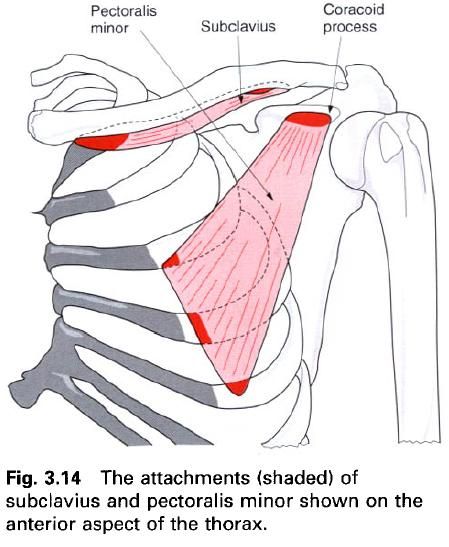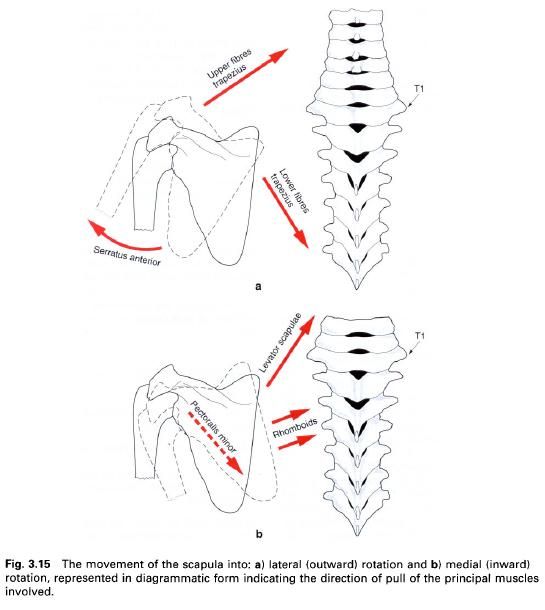Serratus anterior
Pectoralis minor
Serratus anterior
Serratus anterior is a large flat muscular
sheet covering the side of the thorax, being sandwiched between the ribs and
the scapula. Loose fascia exists
between the deep surface of the muscle and the ribs or intercostals fascia, and
also between its superficial surface and subscapularis in order to facilitate
free movement of the scapula.
Serratus anterior forms the medial wall of the axilla, and is partly covered by
the breast inferolaterally. The upper digitations are behind the clavicle while latissimus dorsi crosses
its lower border.
Serratus anterior attaches by fleshy
digitations just beyond the midaxillary line to the outer surfaces of the upper
eight or nine ribs and the intervening intercostal
fascia. The upper digitations arises from ribs one and two, whereas each of
the remaining digitations arise from a single rib. The lower four digitations
interdigitate with the costal attachment of the external oblique of the
abdomen.
From this extensive attachment the muscle
fibres run backwards to insert into the costal
surface on the medial border of
the scapula between the superior and
inferior angles. The digitations are not however evenly distributed in their
attachment to the scapula. The first
passes almost horizontally to the superior angle, while the lower four condense
to attach to the inferior angle, with the intervening ones spread along the
medial border.
Nerve
supply
Serratus anterior is supplied by the long
thoracic nerve, root value C5, 6, 7, with the first two digitations supplied by
C5, the next two by C6 and the remaining four by C7. The nerve enters the
muscle on its superficial aspect. The skin over the accessible parts of the muscle
is supplied by nerves with root values of T3 to T7.
Action
Serratus anterior is a major protractor of the
pectoral girdle and as such is involved in all thrusting, pushing and punching
movements where the scapula is driven
forwards carrying the upper limb with it. Note the massive development of this
muscle in boxers.
Serratus anterior plays a vital role in
stabilizing the scapula during
movements of the upper limb and contracts strongly to hold the medial border of
the scapula against the chest wall
when the arm is flexed or when a weight is carried in front of the body.
Failure to perform this action, as when paralysed, results in “winging” of the
scapula where the medial border stands away from the chest wall, thus severely
affecting the function and mobility of the upper limb.
The lower digitations of the muscle work
together with trapezius to rotate the scapula laterally, so that the glenoid
fossa looks upwards and forwards. When paralysed, the loss of the rotating
action of serratus anterior means that the upper limb cannot be abducted by
more than 90°, thereby seriously limiting the functional capacity of the limb.
There is some controversy as to whether serratus anterior acts as an accessory
muscle of inspiration during respiratory distress. The line of action of the
muscle fibres, except perhaps for the first two digitations and maybe the last,
are not directed to cause elevation of the ribs. Indeed, they are more likely
to cause depression of the ribs.
Palpation
In a muscular subject the digitations of
serratus anterior can be felt and often seen running forwards in the region of
the midaxillary line, especially when performing “press-ups”.
Pectoralis minor
Pectoralis minor is a thin, flat, triangular
muscle situated on the anterior chest wall deep to pectoralis major. Inferiorly
it attaches to the outer surfaces of
the third, fourth and fifth ribs
close to their costal cartilages and the intervening intercostal fascia. There may be additional attachments to the
second or sixth rib, or more rarely, to both. The fibres converge to a short,
flat tendon as they pass superolaterally to attach to the upper surface and medial
border of the coracoid process of
the scapula.
Nerve
supply
Pectoralis minor is supplied by the medial pectoral nerve which pierces it.
However, within the axilla the medial and lateral pectoral nerves communicate,
thereby ensuring that pectoralis minor is supplied by both pectoral nerves. The
segmental supply is by C6, 7 and 8.
Action
By exerting a strong pull on the coracoid
process, the scapula can be pulled forwards and downwards during pushing and
punching movements. When leaning on the hands it helps to transfer the weight
of the trunk to the upper limb. The nature of its attachment to the coracoid
process allows pectoralis minor to help produce medial rotation of the scapula against resistance(figure b).
With the scapula and upper limb
fixed, pectoralis minor may be used as an accessory muscle of inspiration
during respiratory distress.
Palpation
Contraction of pectoralis minor, lying deep to
the great bulk of pectoralis major, is difficult to palpate.












0 коментара:
Постави коментар